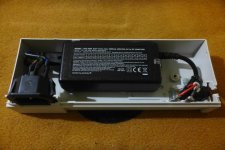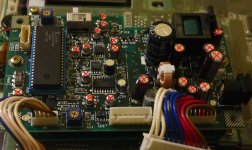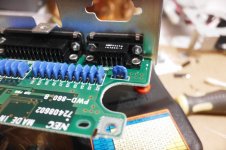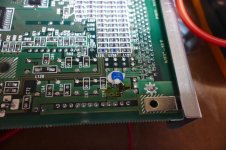All right, finally got sorted it out. If anyone wants to buy one of these "NEW OLD STOCK" Prospeed's - at least now I can give some advice, based on my errors, so you do not have to do it all again
 First - Open the package, and get ready for some serious work - do not even try to turn it on now - the repairs you will have to make will be more difficult /costly, both of time and resources.
First - Open the package, and get ready for some serious work - do not even try to turn it on now - the repairs you will have to make will be more difficult /costly, both of time and resources.
Power Brick will be toast, this I can guarantee! You can try to repair it, but I went the other route - retrofitted modern power adapter inside power brick - it does looks the same from outside when assembled, and performs well. You can use it without retrofitting, however, make sure the polarity is correct - the center is (-), not (+)!
 Second - get some small Philips screwdrivers, and prepare to open the case - not that hard to do:
Second - get some small Philips screwdrivers, and prepare to open the case - not that hard to do:
Remove the keyboard
Remove Battery "brick"
Unscrew 4 screws under battery brick, and 6 under the case
Now, carefully lift the upper part with LCD out of the case - be careful to disconnect two wires - display cable and backlight cable, now you can put LCD aside, and prepare to work.
You need to unscrew 3 more screws in left part - you need to remove the PCB with power distribution unit - it is the cause of most problems in this computer. It feeds mainboard, cooler, LCD backlight, and monitors battery charge/discharge state.
Remove cooling fan and speaker (mounted on metal plate), disconnect the wires, and take out the plate. Now you can start repairing it.
You need to replace capacitors - a lot of them. Brown caps and larger SMD caps need to be replaced. Which ones? I would say - all of them! In three computers, there were no silver SMD caps alive, and maybe one or two brown caps were OK. If you have an ESR mater, you might try to save on not replacing some with good reading, but it is not reccomended.
Here is the picture of the caps which will need to be replaced:
 All right, so, the things you need now:
All right, so, the things you need now:
A very fine soldering iron (preferably soldering station)
Get all capacitors you need - at least they are all marked, so no problem to guess the right values
A lot of patience, especially working with SMD caps they are very small, and the soldering points are even smaller
Now, assemble the unit back, and turn on the power switch - fingers crossed - most likely it will work now.
Should you ask, what happens, if you do not follow this route (as I did before):
The computer will be very unresponsive - it will be difficult to turn it on (it eventually will)
There will be huge power spikes, which results in flickering screen/hard drive/floppy shutting down
RAM/CMOS errors will be reported by the system
Battery charging system will not work
The laptop will not "understand" if it is working on AC or battery - it might show DC power when running from AC and AC when running from the battery pack
There might be false sense of "things normalizing"- the flicker/spikes might go away, however, this is the part where the caps start to leak, and finally the computer will become unstable and refuse to work. I have bricked one of my NEC's this way - power spikes damaged other components on the mainboard.
Other than caps issue, this is a really nice, responsive 386 system, and the feeling of opening "brand new" 26 years old PC is a very special one - the plastic is white, no scratches, no damages, keyboard cable is soft, no cracks or anything. The backlight is great even on lowest brightness settings







